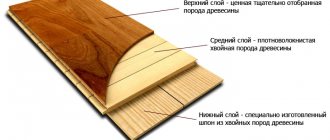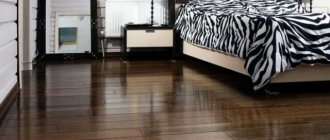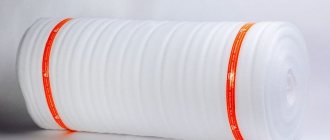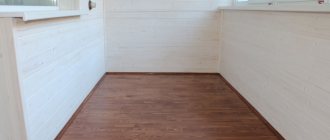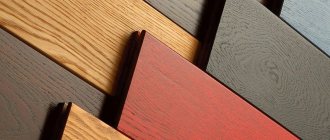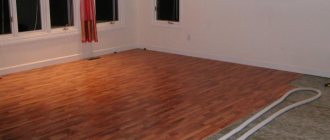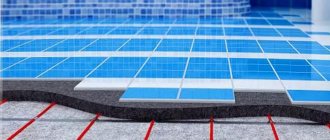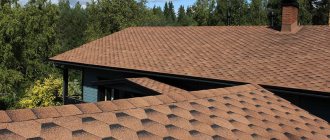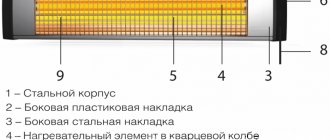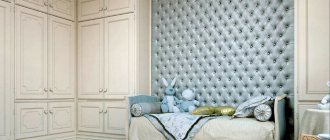In order for the laminate to serve faithfully for the entire period stated by the manufacturer, it must be laid correctly, strictly following the installation technology. For example, one of the prerequisites for laying and operating the material is the presence of a substrate layer underneath it. Nowadays, in light of the popularity of caring for one’s health and attention to the environmental situation in the apartment, coniferous underlay for laminate flooring is especially popular. How to choose the right material? Which manufacturer should you choose? How to lay the underlay? We will answer these questions in detail later in the article.
Coniferous underlay for laminate
Coniferous underlay for laminate
Careless craftsmen or newcomers to the world of construction are always trying to save money on all types of work. Naturally, the desire to spend as little money as possible also appears when laying laminate flooring. Some try to cut costs by not purchasing a substrate. But such a measure would be a gross violation of the entire material laying technology.
In the absence of a substrate that acts as a special shock absorber, the laminate will quickly become unusable - the locking connections of individual lamellas will be hopelessly damaged, as a result of which the coating will begin to move apart, cracks will appear, and debris that gets through them will cause the floor to creak. That is why you cannot neglect the use of a substrate.
Laying laminate on a substrate
Using laminate in the hallway, you can get an aesthetically attractive, strong, reliable and durable floor covering. We will tell you how to choose this material correctly in a special article.
Now on the construction market there is a huge variety of different types of laminate substrates. They differ in price, terms and characteristics of operation, quality, production technology, manufacturing materials and other factors. Recently, coniferous substrates made from natural raw materials have become popular.
Expert opinion
Afanasyev E.V.
Chief editor of the pol-exp.com project Engineer.
Coniferous underlay is a special and completely natural material, which, like other types of underlays, allows you to partially hide small defects in the subfloor and ensure the safe operation of the laminate. It is especially suitable for installation in those houses and apartments whose owners are concerned about their health, and a favorable environmental situation for them is not just empty words.
Using a coniferous substrate
On a note! Compared to other types of substrates, coniferous has a fairly high price - however, like any environmentally friendly material.
The coniferous substrate contains only natural ingredients. The base is coniferous wood and pressed pine needles. The wood is crushed, then evaporated, and then the substrate layers themselves are formed from such raw materials. The material acquired wear resistance, hydrophobicity of a certain level, heat and sound insulation properties due to the fact that it included various additional components. And the binding component in the raw material is the resin of coniferous trees, which, by the way, is also a natural substance.
Coniferous underlay for STEICO Underfloor laminate
The structure of the coniferous substrate is porous, due to which the material has heat-protective properties and can, to some extent, become a sound insulator. At the same time, the substrate breathes well, allowing fresh air into the room.
Installation of coniferous substrate
Why is coniferous underlay optimal for laminate flooring?
Laminate substrates must meet certain requirements. Otherwise they will not work correctly.
- Good leveling abilities. Due to the fact that the base of the floor will be as level as possible, the laminate will last longer than without the use of a substrate.
Technical characteristics of the substrate for laminate LATTIALEIJONA (“Lattilona”)
- Soundproofing abilities. If the substrate does not absorb sounds, then all steps and movements on the laminate will be clearly audible to household members and even neighbors.
- The material must have moisture-proofing properties. The substrate must protect the laminate from excessive moisture acting on it from the concrete surface.
- Thermal conductivity ability. If you plan to lay a heated floor under the laminate, it is important to choose a substrate that is capable of transmitting and transmitting heat. Otherwise, the effect of heated floors will be insignificant.
There are certain requirements for the substrate under the laminate
Coniferous underlayment has excellent thermal insulation properties, so sometimes you can completely abandon the underfloor heating system, since the material itself will perfectly retain heat in the room. Also, the coniferous backing allows air to pass through and at the same time absorbs moisture, so the laminate will remain dry.
On a note! Since coniferous underlayment is a porous material, it is recommended to install it in rooms with a normal level of humidity. Where it is elevated, it is recommended to carry out additional waterproofing work. If excess water gets on the pine needle substrate, mold may appear on it - after all, this is a favorable material for the development of various parasites.
Where is coniferous backing used?
Results
The use of underlays is advisable when you use so-called floating laminate floors. This is the simplest technology that professionals like due to its speed.
An underlay is a must when installing floating laminate floors.
Previously, it was recommended to install floors of this kind with glue, which completely reduced the likelihood of squeaks, bends and other troubles. The base was well leveled under each lamella. In addition, for laying with glue, an inexpensive laminate was used, which does not have complex locks. Substrates were not necessary.
However, this work requires more time and effort, and this causes a negative reaction from both workers and firms. That's why the so-called floating method arose. Floors should not float at all, they should be stable. The final verdict regarding the installation of laminate flooring should be made by the customer after he has studied in detail the specifics of his home.
What types of coniferous substrates are there?
Coniferous substrates can be divided into several categories according to two parameters - the release form and the thickness of the sheet.
Table. Forms of release of pine needle substrate.
| Form | Installation features |
| Sheet | It is a material that comes in the form of small sheets. Thanks to this, installation and cutting of the substrate is very convenient. Beginners are advised to purchase material in this form, as it is easier to install. The installation of the substrate is done in strips; individual elements are sometimes glued together with special moisture-resistant tape or glue. |
| Roll | An ordinary coniferous substrate, but produced in roll format. Installation is carried out from the walls to the center of the room. This format is more difficult to work with, but it is more often chosen by professionals. |
Also, the substrate may differ in thickness. In general, this parameter can vary from 3.6 to 7 mm. Its price will depend on the thickness of the material. A substrate that is 4 mm thick copes well with floor unevenness of 1 mm, and if the material is 5 mm thick, then it masks 1-2 mm unevenness; A 7mm backing will successfully hide irregularities measuring 3mm.
Coniferous substrate Isoplaat
On a note! Some manufacturers make such a substrate to order, so purchasing a non-standard option that is convenient for each specific case is quite simple.
When choosing a substrate, the evenness of the rough base will play a decisive role. A substrate that is too thin and the floor is too curvature will not work as needed, which will lead to damage to the laminate. In general, the backing layer should be slightly smaller than the thickness of the lamellas.
Material price
The cost of a cork substrate is affected by its thickness - the thicker it is, the higher the price. The average value ranges from 70 to 750 rubles per m² for rolled material and from 400 to 1000 per m² for sheet varieties. When choosing cork as a lining for laminate and other decorative coverings, you should not save money, since the use of a low-quality lining will soon lead to damage to the floor covering.
In some cases, it is worth thinking about the advisability of purchasing expensive material. The construction market offers a wide range of cheaper linings with excellent performance properties. Buying an expensive cork when laying cheap laminate flooring is not profitable.
Table 3. Average cost per material
| Name | Thickness, mm | Average cost as of March 2021, rubles |
| 2 | 148 | |
| 4 | 205 | |
| 5 | 3800 | |
|
| |
|
|
Advantages and disadvantages
The pine needle substrate has its advantages and disadvantages, like any other material. Only by knowing them will it be possible to determine whether the substrate is suitable for installation in each specific case. The advantages of this type of material:
- good soundproofing qualities;
- additional floor leveling;
- thermal insulation properties;
- environmental cleanliness and health safety;
- ability to keep its shape well throughout the entire period of use;
- optimal level of density;
- ease of installation.
Coniferous substrate has many advantages
Disadvantages of pine needle substrate:
- cannot be used in rooms with high humidity levels;
- an unpleasant odor that disappears only after 3-4 days from the moment the package is opened and the material is laid;
- high price;
- Coniferous substrate is a favorable environment for the development of fungus and mold.
On a note! Coniferous underlayment can only be laid on a well-dried base. Otherwise, there is a risk of mold growth.
TOP 3 manufacturers of substrates based on pine needles and wood
| Photo | Name | Rating | Price | |
| #1 | Steico underfloor | ⭐ 98 / 100 | More details | |
| #2 | Leroy Merlin | ⭐ 97 / 100 | More details | |
| #3 | Isoplaat | ⭐ 96 / 100 | More details |
Steico underfloor
This spruce underlay is good where soundproofing of floors is important. Supplied in slab form. Ideal for laying under laminate on wooden floors. Often used in private homes. Steico is a leader in the production and sale of this type of substrate.
Steico underfloor (Poland)
pros
- perfectly dampens the sound of steps when moving along the base;
- has excellent thermal insulation properties;
- able to resist moisture well;
Minuses
- afraid of mold.
coniferous underlay Steico underfloor
Leroy Merlin
It acts as a capacitor for the lamellas due to the fact that it is subjected to special processing during manufacturing. This substrate is cheaper than the previous option, but its performance characteristics are quite good.
Coniferous backing from Leroy Merlin
pros
- ideal ratio of cost and quality;
- good soundproofing qualities;
Minuses
- not detected
coniferous backing Leroy Merlin
Isoplaat
The material is able to retain its shape for as long as possible. Suitable for repairing old floors.
Isoplaat (Estonia)
pros
- does not deform;
- absorbs noise well;
- can act as an insulating material;
- does not allow the laminate to cool quickly.
Minuses
- the cost is above average.
coniferous underlayment Isoplaat
How to lay spruce underlayment
The process of installing a spruce substrate is quite simple; anyone who carefully studies the instructions can handle it. The most important thing is to follow the basic rules, which will ensure high-quality installation.
Coniferous backing sheets
It is important to remember that the substrate must be laid on an already prepared rough base. That is, it is pre-cleaned of dirt, debris and even dust. The fact is that even the smallest foreign objects can ruin the entire work. If the floor is very uneven, it is recommended to lay it with sheets of chipboard or plywood, or even fill it with fresh screed. It is also important to first subject the floors to a waterproofing process - for example, lay polyethylene film on the base and seal all joints with tape.
Advice! The thickness of the polyethylene film must be at least 0.2 mm. Only then will the material meet the specific density requirements required for the waterproofing layer.
You will also have to worry about purchasing the tools that will be needed to lay this type of substrate. For this, you will need a tape measure and a marker or pencil for marking, as well as household scissors for cutting the material. You can also use a sharp utility knife.
We prepare everything you need
Before installation, it is recommended to bring the natural substrate into the room where the flooring will be installed. Let it sit for about 1-2 days - this time will be enough to adapt to operating conditions.
Step 1. Since the material must be laid so that the joints between the individual base plates do not coincide with the joints of the lamellas, the first elements that will be laid must be cut at a certain angle - 45 degrees. The substrate is laid at a right angle relative to the laminate. The backing sheets are marked using a tape measure and a pencil.
The first elements of the substrate are cut at an angle of 45 degrees
Step 2. Next, the material is cut. For this, a stationery knife and scissors are used. When cutting, it is convenient to use a long ruler or lamella and cut the material along it.
Cutting coniferous substrate
A lamella is used to cut the material
Step 3. Laying the first sheets (cut) is done joint to joint at an angle of 45 degrees along one of the walls. In this case, a small compensation gap is left between the substrate and the wall - about 5 mm.
Laying the first sheets of backing
Step 4. Next, whole sheets of material are also laid joint-to-joint.
Laying complete sheets of underlayment
Step 5. Then lay the laminate in the traditional way.
You will find detailed step-by-step instructions for laying laminate flooring in the article . ” We talk about the nuances, choosing a substrate and its types, the installation process and how to cut holes.
Laminate installation
On a note! To secure individual pieces of rolled backing, if this is the option used, double-sided tape may be useful. Sheet elements can also be glued together with tape or glue.
Prices for coniferous underlay for laminate flooring
coniferous underlay for laminate
Video - Laying coniferous substrate
There are many opinions regarding coniferous substrate. Some say that it is quite easy to install and has excellent performance indicators, others say that it quickly becomes unusable due to its tendency to mold. However, you will have to decide whether to use it or not on your own. One thing is indisputable - coniferous substrate can rightfully bear the title of the most environmentally friendly material belonging to this category. And if it is laid correctly, then you don’t even have to think about the appearance of mold.
"Dry" method
Before you begin laying the underlay, the rolls are unpacked and left in the room for 24 hours to acclimatize.
Table 4. Process of installation on double-sided tape
| Illustration | Description |
| Cork is capable of absorbing moisture, so when laying it on a concrete base, polyethylene with a thickness of no more than 150 microns is first laid as a water barrier. The film is placed on the walls around the perimeter of the room to a height of at least 5 cm. | |
| Lay out the backing. | |
| At the joints with the wall, the material is trimmed. | |
| The joints are glued with tape, ensuring the immobility of the layer. | |
| A tight fit of the substrate can be ensured by fixing it with double-sided tape. If the concrete floor is not located on the first floor, then the film can not be laid, but installation can be done directly on a clean, primed base. | |
| Strips of double-sided tape are glued to the floor so that two adjacent strips of backing can be fixed to them. | |
| It is important to ensure that the sheets fit tightly and there is no gap between them. The top joints are also taped with tape. |
Note! Laying sheet and roll material is carried out using different technologies. If the rolled material is laid sequentially in strips, starting from the wall, then the sheet material is laid with offset joints.
There should be at least 1 cm of free space between the wall and the edge of the cork lining - the natural material should be able to expand when the temperature and humidity in the room changes. If this condition is neglected, deformation of the final coating is possible.
